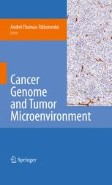Search
Search Results
-
C6 Immunostimulants in cancer therapy
Immunoaugmenting agents have been used to treat disease since William B. Coley treated cancer patients with mixed bacterial toxins early in the 20th...
-
Acute Promyelocytic Leukaemia
Since the time of its first description (Degos 2003), Acute Promyelocytic Leukaemia (APL) has drawn the attention of clinicians and scientists for...
-
Phenomenon of evolution of clonal chromosomal abnormalities in childhood acute myeloid leukemia
An analysis of chromosomal abnormalities in bone-marrow cells was performed in 116 children with diagnoses of acute myeloid leukemia (AML). The...
-
Modulation of Philadelphia Chromosome-Positive Hematological Malignancies by the Bone Marrow Microenvironment
Hematological malignancies often have cytogenetically distinct chromosomal translocations, resulting in fusion proteins that lead to deregulation of...
-
Molecularly Targeted Therapy for Infant ALL
Rational combinations of molecularly targeted agents with synergistic conventional cytotoxic chemotherapeutic agents or, ultimately, with one another...
-
Use of Filgrastim and Pegfilgrastim to Support Delivery of Chemotherapy
Neutropenia is a serious hematologic toxicity of myelosuppressive chemotherapy. The discovery that granulocyte colony-stimulating factor (G-CSF)...

-
A dose-effect relationship for deltaretrovirus-dependent leukemogenesis in sheep
BackgroundRetrovirus-induced tumors develop in a broad range of frequencies and after extremely variable periods of time, from only a few days to...

-
Growth and differentiation factors as cancer therapeutics
Differentiation therapy for the treatment of malignant disorders offers an attractive alternative to the conventional cytotoxic chemotherapy. The...
-
Early and transient reverse transcription during primary deltaretroviral infection of sheep
BackgroundIntraindividual genetic variability plays a central role in deltaretrovirus replication and associated leukemogenesis in animals as in...

-
Arsenic trioxide: safety issues and their management
Arsenic trioxide (As 2 O 2 ) has been used medicinally for thousands of years. Its therapeutic use in leukaemia was described a century ago. Recent...
-
Front Line Clinical Trials and Minimal Residual Disease Monitoring in Acute Promyelocytic Leukemia
In spite of the very high cure rate (70%–80%) achieved in APL with combinatorial all-trans retinoic acid (ATRA) and anthracycline-based chemotherapy...
-
Treatment of Acute Promyelocytic Leukemia by Retinoids
We review the role of all-trans retinoic acid (ATRA) in the treatment of acute promyelocytic leukemia (APL). The combination of ATRA and conventional...
-
Prevention and treatment of hyperuricemia with rasburicase in children with leukemia and non-Hodgkin’s lymphoma
To prevent acute renal failure in children at risk for develo** tumor lysis syndrome due to acute lymphoblastic leukemia or non-Hodgkin’s lymphoma...
-
Arsenic Trioxide and Acute Promyelocytic Leukemia: Clinical and Biological
Arsenic has recently been identified as an effective drug in the treatment of newly diagnosed and relapsed acute promyelocytic leukemia. Indeed,...
-
Hematologic Malignancies
Chromosome aberrations, mostly translocations, and viral infections are frequent causes for hematologic malignancies. The clonal development of T-...
-
Inhibitors of histone deacetylases induce tumor-selective apoptosis through activation of the death receptor pathway
Histone deacetylases (HDACs) regulate transcription and specific cellular functions, such as tumor suppression by p53, and are frequently altered in...

-
Bacillus cereus pneumonia in a patient with acute lymphoblastic leukemia
Reported here is a case of Bacillus cereus pneumonia that occurred in a patient with acute lymphoblastic leukemia. The presentation was severe,...
-
Severe peritonitis due to Balantidium coli acquired in France
The case reported here concerns an alcoholic pork-butcher who presented with severe colitis with peritonitis, caused by the only ciliate protozoan...

-
CYFRA 21-1 is a prognostic determinant in non-small-cell lung cancer: results of a meta-analysis in 2063 patients
The purpose of this study was to determine the prognostic significance of a high pretreatment serum CYFRA 21-1 level (a cytokeratin 19 fragment)...

-
Acute Lymphoblastic Leukemia
Unlike the situation in acute myeloid leukemia, in which there are at least eight morphological French-American-British (FAB) subtypes identified by...
